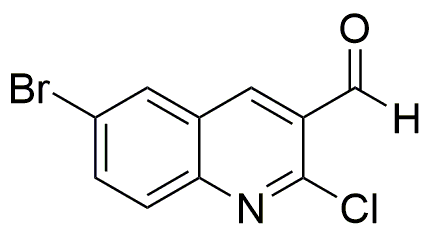6-Bromo-2-chloroquinoline-3-carboxaldehyde is widely utilized in research focused on:
- Pharmaceutical Development: This compound serves as an important intermediate in the synthesis of various pharmaceuticals, particularly those targeting infectious diseases and cancer. Its unique structure allows for modifications that enhance biological activity.
- Antimicrobial Agents: It is used in the development of new antimicrobial agents. Researchers are exploring its efficacy against resistant strains of bacteria, making it a valuable candidate in the fight against antibiotic resistance.
- Fluorescent Probes: The compound can be employed in the creation of fluorescent probes for biological imaging. Its ability to fluoresce under specific conditions aids in visualizing cellular processes, which is crucial for biomedical research.
- Material Science: In material science, it is utilized in the formulation of advanced materials, including polymers and coatings, that require specific chemical properties for enhanced durability and performance.
- Research in Organic Synthesis: The compound is a valuable building block in organic synthesis, allowing chemists to create complex molecules efficiently. Its reactivity and functional groups facilitate various chemical reactions, making it a versatile tool in synthetic chemistry.
General Information
Properties
Safety and Regulations
Applications
6-Bromo-2-chloroquinoline-3-carboxaldehyde is widely utilized in research focused on:
- Pharmaceutical Development: This compound serves as an important intermediate in the synthesis of various pharmaceuticals, particularly those targeting infectious diseases and cancer. Its unique structure allows for modifications that enhance biological activity.
- Antimicrobial Agents: It is used in the development of new antimicrobial agents. Researchers are exploring its efficacy against resistant strains of bacteria, making it a valuable candidate in the fight against antibiotic resistance.
- Fluorescent Probes: The compound can be employed in the creation of fluorescent probes for biological imaging. Its ability to fluoresce under specific conditions aids in visualizing cellular processes, which is crucial for biomedical research.
- Material Science: In material science, it is utilized in the formulation of advanced materials, including polymers and coatings, that require specific chemical properties for enhanced durability and performance.
- Research in Organic Synthesis: The compound is a valuable building block in organic synthesis, allowing chemists to create complex molecules efficiently. Its reactivity and functional groups facilitate various chemical reactions, making it a versatile tool in synthetic chemistry.
Documents
Safety Data Sheets (SDS)
The SDS provides comprehensive safety information on handling, storage, and disposal of the product.
Product Specification (PS)
The PS provides a comprehensive breakdown of the product’s properties, including chemical composition, physical state, purity, and storage requirements. It also details acceptable quality ranges and the product's intended applications.
Certificates of Analysis (COA)
Search for Certificates of Analysis (COA) by entering the products Lot Number. Lot and Batch Numbers can be found on a product’s label following the words ‘Lot’ or ‘Batch’.
*Catalog Number
*Lot Number
Certificates Of Origin (COO)
This COO confirms the country where the product was manufactured, and also details the materials and components used in it and whether it is derived from natural, synthetic, or other specific sources. This certificate may be required for customs, trade, and regulatory compliance.
*Catalog Number
*Lot Number
Safety Data Sheets (SDS)
The SDS provides comprehensive safety information on handling, storage, and disposal of the product.
DownloadProduct Specification (PS)
The PS provides a comprehensive breakdown of the product’s properties, including chemical composition, physical state, purity, and storage requirements. It also details acceptable quality ranges and the product's intended applications.
DownloadCertificates of Analysis (COA)
Search for Certificates of Analysis (COA) by entering the products Lot Number. Lot and Batch Numbers can be found on a product’s label following the words ‘Lot’ or ‘Batch’.
*Catalog Number
*Lot Number
Certificates Of Origin (COO)
This COO confirms the country where the product was manufactured, and also details the materials and components used in it and whether it is derived from natural, synthetic, or other specific sources. This certificate may be required for customs, trade, and regulatory compliance.


